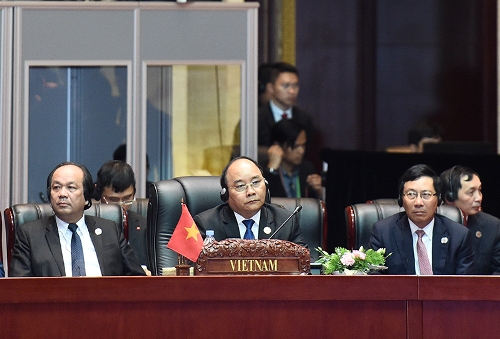 |
|
Photo: VGP/Quang Hieu
|
International regulations closely followed
After the opening ceremony, leaders in ASEAN gathered at the 28th ASEAN Summit, focusing discussions on the implementation of the ASEAN Vision 2025 and orientations to strengthen ASEAN cooperation in the future.
The Vietnamese PM hailed positive achievements of the ASEAN Community in its fist year, and crucial efforts and the role of Laos as Chair of ASEAN in 2016.
Stressing the improvement of capacity and self-reliance of ASEAN and its central role, the PM regarded it as an important factor for the success of the bloc.
Each member country is responsible for enhancing solidarity and unity within ASEAN, he said, suggesting harmoniously connecting the national benefits and the benefits of ASEAN.
Members in ASEAN need to accelerate consultancy and raise their common voice in regional issues, which directly affect ASEAN’s security and development as well as orientations in relations with partners and regional structure formation.
He asked to identify key priorities in realizing the ASEAN Vision 2025 and plans on each pillar.
In term of politics and security, ASEAN should boost up activities to establish belief, preventive diplomatic measures, uphold principles and standards of ASEAN, highlight the compliance with the international laws, especially the United Nations Convention on the Law of the Sea 1982, respect the diplomatic and legal progress, maintain peace and security, prevent conflicts in the region as well as cooperate in responding to non-traditional security challenges, especially terrorism and network security.
Regarding economic issues, PM Phuc proposed launching measures to facilitate trade, improve investment and the business environment, develop Small and Medium-sized enterprises in value-added and high-contained technology areas, enhance regional cooperation and supervise the macro-economy and ensure financial and monetary sustainability.
He stressed promoting cultural and people-to-people exchanges, guarantee social security, develop human resources, protect the environment and cope with climate change and natural calamity.
The Vietnamese leader required connecting and narrowing the development gap, concentrating on the development of highways, railway systems, maritime and aeronautical lines and improving the integration capacity of Cambodia, Laos, Myanmar and Viet Nam.
Heading to celebrate the 50th anniversary of the establishment of ASEAN, the PM suggested enhancing communication and advertisement activities to encourage the participation of people, enterprises and all social strata and create consensus and support for ASEAN cooperation, committing that Viet Nam will coordinate with other member country to launch realistic and effective activities to make contribution to ASEAN after half of century of formation and development.
Five key areas
At the summit, leaders hailed the progress made in realizing plans, especially eight prioritized areas in 2016 including narrowing the development gap, facilitating trade, transforming the economy, development small- and medium-sized enterprises, tourism, connecting and cooperation in heritage and culture.
Delegates agreed to continue realizing the ASEAN Vision 2025 and overall plans in three pillars of politics-security, economics and society-culture to make the ASEAN connectivity more effective.
Leaders from ASEAN approved the Master Plan on ASEAN Connectivity 2025 and the third phase of the Initiative for ASEAN Integration (IAI).
Accordingly, the Master Plan on ASEAN Connectivity focuses on five strategic areas such as sustainable infrastructure development, digital creativity, unbroken supply chain, optimizing policy planning and realization , education, vocational training and intra travel.
The IAI heads to five prioritized areas including food and agriculture, trade facilitation, the development of small and medium-sized enterprises, health and welfare, training and labor to help Cambodia, Laos, Myanmar and Viet Nam narrow the development gap, aiming for an ASEAN of equal and sustainable development.
Later, they held dialogues with representatives from the ASEAN Inter-Parliamentary Council, the ASEAN Youth Organization and the ASEAN Business Advisory Council.
The same day, leaders of ASEAN nations joined the signing ceremony of the ASEAN Declaration on One ASEAN, One Response: ASEAN Responding to Disasters as One in the Region and Outside the Region, adopt the Master Plan on 2025 ASEAN Connectivity and the third phase of the Initiative for ASEAN Integration Work Plan, and debut the “Visit ASEAN@50” campaign logo.
By Thuy Dung